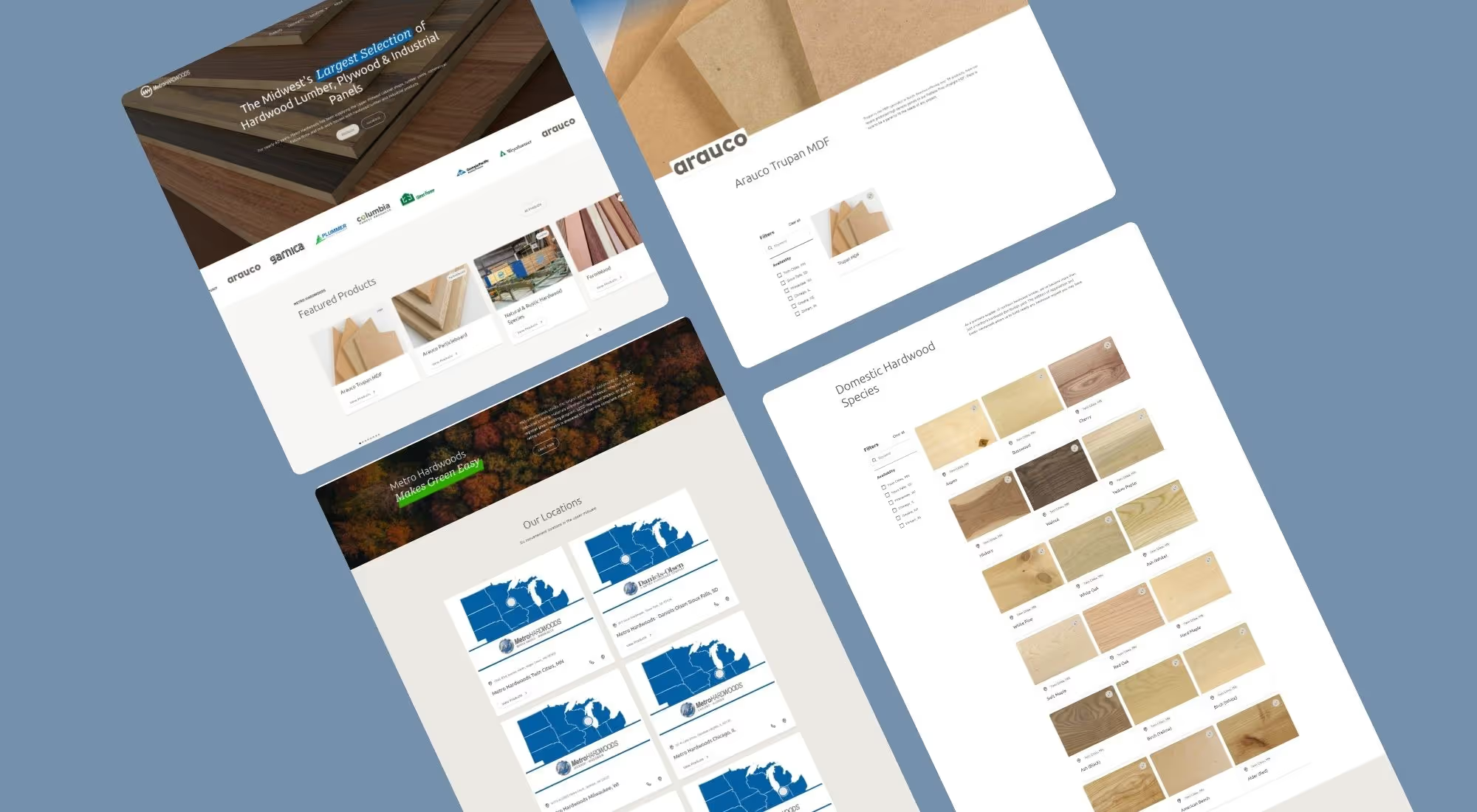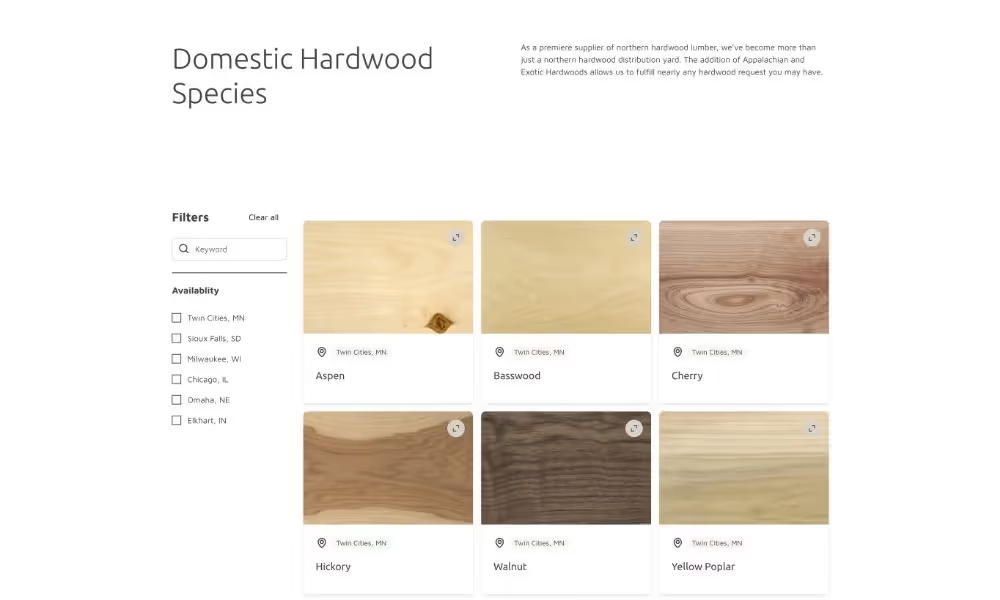
Metrohardwoods
Data-Driven Product Management: Streamlining Metro Hardwoods' Digital Presence
The Metro Hardwoods website represents a sophisticated integration of database management and content synchronization. This case study explores how the platform leverages Airtable, Whalesync, and Webflow to create both an easily maintainable product catalog and a location-aware user experience.
Project Background and Objectives
Metro Hardwoods approached the development team with a significant challenge: they needed a digital platform that would showcase their extensive product offerings while being easy to maintain without constant developer intervention. As the Midwest's largest supplier of hardwood lumber, plywood, and industrial panels for nearly 40 years, they required a solution that would reduce the manual effort involved in keeping their product catalog current across multiple locations.
The project began with several key objectives:
Content Maintainability: Create a system that would allow non-technical staff to easily update product information, availability, and resources without requiring developer assistance.
Location-Specific Filtering: Develop a mechanism for customers to view products and resources specific to their preferred Metro Hardwoods location.
Resource Organization: Implement a structured presentation of technical documents, stock lists, and other resources that would help customers find relevant information quickly.
Database Integration: Establish a reliable connection between an easy-to-use database system and the website's content management system.
These objectives guided both the technical architecture and user experience decisions throughout the project.
Design Strategy: User-Focused Information Architecture
The design strategy for Metro Hardwoods focused on creating a digital experience that would effectively communicate their extensive product catalog while maintaining visual clarity:
Content Presentation
The content structure was carefully designed to maximize usability and information access:
Product Categorization The product presentation system employs a thoughtful categorization approach:
- Primary Product Categories: Products are organized into clear categories (Lumber, Plywood, TFL Melamine, etc.) that align with how customers typically conceptualize their material needs.
- Filtering System: The filtering interface allows visitors to quickly narrow down products by type, creating an efficient browsing experience.
- Location-Aware Presentation: Product availability is filtered based on customer location preference, ensuring that customers only see relevant offerings.
- Consistent Format: Each product category maintains a consistent presentation format, helping visitors quickly locate and compare specific products across categories.
Resource OrganizationThe document and resource section employs a structured approach to information:
- Category-Based Organization: Resources are organized by type (Stock Lists, Brochures, Safety Data Sheets, etc.), allowing visitors to quickly locate specific document types.
- Searchable Interface: The keyword search functionality enables visitors to quickly locate specific resources without extensive browsing.
- Visual Distinction: Clear visual cues distinguish between different resource types, enhancing scannability and navigation.
- Contextual Grouping: Related resources are grouped together, helping visitors understand relationships between different documents.
This thoughtful organization ensures that content is not only accessible but presented in a way that aligns with customer needs and usage patterns.

Technical Implementation: Database-Driven Content Management
The technical implementation of the Metro Hardwoods website focused on creating a sustainable, maintainable system that would empower internal staff while providing an excellent customer experience:
Airtable Implementation
The solution leverages Airtable's capabilities to create a flexible, user-friendly database system:
Structured Data Architecture The Airtable base employs a thoughtful data structure for optimal usability:
- Relational Product Database: The implementation uses Airtable's relational database capabilities to connect products, specifications, locations, and availability in a structured, maintainable system.
- User-Friendly Interface: Airtable's intuitive spreadsheet-like interface allows non-technical staff to easily update product information without specialized training.
- Media Management: Product images and resource files are organized within the Airtable system, creating a centralized asset repository.
Location-Based Data Organization The database structure incorporates location awareness:
- Location-Product Relationships: Products are associated with specific locations, allowing for accurate filtering based on customer preference.
- Resource Association: Documents and resources can be associated with specific locations when relevant, ensuring customers access location-appropriate information.
- Centralized Management: Despite the location-specific data, all information is managed in a single, centralized system for administrative efficiency.
These technical decisions create a foundation that balances ease of use for administrators with data integrity and structure.
Whalesync Integration
The implementation incorporates Whalesync to create a seamless connection between the database and website:
Automated Synchronization SystemThe synchronization system creates a reliable flow of information:
- Bidirectional Data Flow: Whalesync enables bidirectional synchronization between Airtable and the Webflow CMS, ensuring consistency across systems.
- Field Mapping: Careful field mapping ensures that data from Airtable is correctly formatted and positioned within the Webflow CMS.
- Performance Optimization: The synchronization process is optimized to minimize resource usage and maintain website performance.
This thoughtful integration of Whalesync creates a technical implementation that is both robust and maintainable, reducing the technical burden on the Metro Hardwoods team.
User Experience Design: Location-Aware and Intuitive
The user experience design for Metro Hardwoods creates an engaging journey that effectively communicates their extensive product offerings:

Navigation and Information Discovery
Several features were specifically designed to facilitate efficient information access:
Location-Based Filtering
The location awareness system enhances relevance for customers:
- Location Selector: Customers can select their preferred location, which then filters products and resources to show only relevant items.
- Persistent Location Context: The selected location preference is maintained throughout the browsing session, creating a consistent, personalized experience.
- Visual Location Indicators: Clear visual cues indicate when content is location-specific, helping customers understand the context of the information they're viewing.
Product Discovery Features The content presentation is optimized for efficient product exploration:
- Faceted Filtering: The filtering system allows customers to quickly narrow down products based on multiple attributes simultaneously.
- Category Navigation: Intuitive category navigation helps users explore products by type, with visual cues indicating product volume and variety.
- Search Enhancement: The search functionality includes product specifications and descriptions, helping customers quickly find specific materials.
These discovery features transform what could have been an overwhelming product catalog into an intuitive, efficient information experience.
Conclusion
The Metro Hardwoods website demonstrates how thoughtful integration of database systems and content synchronization can create a platform that is both user-friendly for customers and maintainable for internal teams. By combining Airtable's flexible database capabilities, Whalesync's synchronization technology, and Webflow's content management system, the implementation created a solution that addresses both customer needs and operational efficiency.
This case study illustrates that investing in both the customer-facing experience and internal workflow efficiency can yield significant returns. The Metro Hardwoods website succeeds by recognizing that maintainability and user experience are not competing priorities but complementary elements of a successful digital strategy. Through careful attention to data structure, synchronization processes, and location-aware design, the implementation creates a digital presence that authentically represents Metro Hardwoods' extensive offerings while significantly reducing the technical burden of website maintenance.

